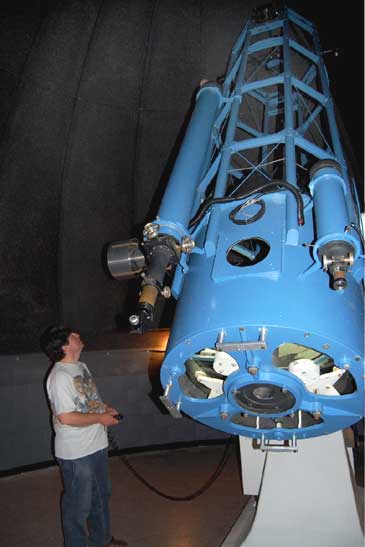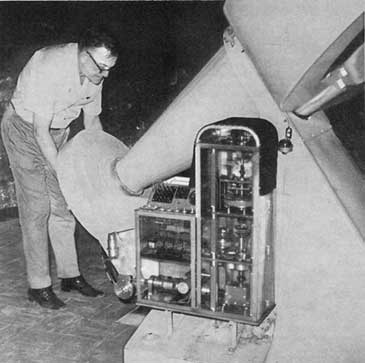 |
|
The primary instrument at SRO is a fork-mounted, 30-inch (0.76-m) Newtonian-Cassegrain reflector designed for multiple focal ratios of f/6 (Newtonian focus) and f/25 (Cassegrain focus). This superb instrument was designed and built by George A. Carroll with considerable help from the members of Stony Ridge Observatory. When completed in 1963, Stony Ridge's 30-inch telescope was the eighth-largest telescope in California, and most likely the largest amateur telescope in the world. Between 1957 and 1963, SRO members produced a film that documented the progress of the construction of the telescope and observatory - from the delivery of the mirror blank for grinding and polishing in Altadena, CA, to the opening of the dome and celebration of first-light in 1963. You may view or download a digital version here. One unique design feature of the telescope was the use of a dual-chain, friction drive system that did not rely on expensive, high-precision gears to accurately move the telescope to follow the stars in the sky. This system has worked with accuracy and precision for 47 years. The primary mirror, made from a disk of Hayward C-3 glass, was ground and polished by members of SRO under the direction of Roy Ensign and Easy Sloman. Roy did the final polishing,figuring and testing of the mirror. The raw glass blank started out weighing over 400 pounds(181 kg) and was several inches thicker than it is now. The finished mirror tips the scale at about 300 pounds (136 kg) and is 5-inches (12.5 cm) thick (a thickness ratio of 6:1 was typical for astronomical mirrors of that time). Any amateur telescope maker who has "pushed glass" will certainly wince at that amount of glass worn away. But thanks to Roy's motorized grinding machine, the grinding was only endlessly noisy and nerve racking, not muscle stressing. Four eyepiece/instrument ports, located near the top end of the telescope tube at the Newtonian focus, are positioned at each of the 4 cardinal points. A rotating secondary mirror is computer controlled (a recent upgrade) to position itself to reflect the image path to the desired observing port. A fifth port is located at the back of the telescope tube, at the Cassegrain focus. The Newtonian secondary flat-mirror is switched out with a round convex-mirror that reflects the image from the primary mirror, returning it back to the primary and through a hole in the center of that mirror, to the Cassegrain focus, located outside the back of the tube. The main telescope tube has two refractor telescopes mounted to it, a 5-inch (12.5 cm) f/5, and a 6-inch (15.2 cm) f/15 telescope. These instruments, including the optical glass lens elements, were both designed and built by George Carroll. The 6-inch telescope has an movable x/y stage in front of the eyepiece which allows the observer to reposition the image in relation to the image being observed through the 30-inch. This feature is particularly useful when selecting guide stars when imaging through the main telescope. Upgrades to the telescope As new technologies have been developed through the years, Stony Ridge Observatory has endeavored to keep pace. As a longtime SRO member, Timothy Cann has been Stony Ridge's guiding light through these years of paradigm shifts. A professional IT consultant by trade, with the passion and skills to produce high-precision machine work, Tim has continued to keep the parts of the mechanism called Stony Ridge Observatory repaired, greased, maintained and moving forward for many years. During the 1980's, one of Tim's first upgrades was to convert the telescope's electrical system, a 28-volt DC system borrowed from George Carroll's professional occupation as an aircraft designer, to a "modern-day" 110-volt AC system. This upgrade required a complete rebuild of the original drive motors. *************************** |
***************************
|
|
webmaster@stony-ridge.org |

